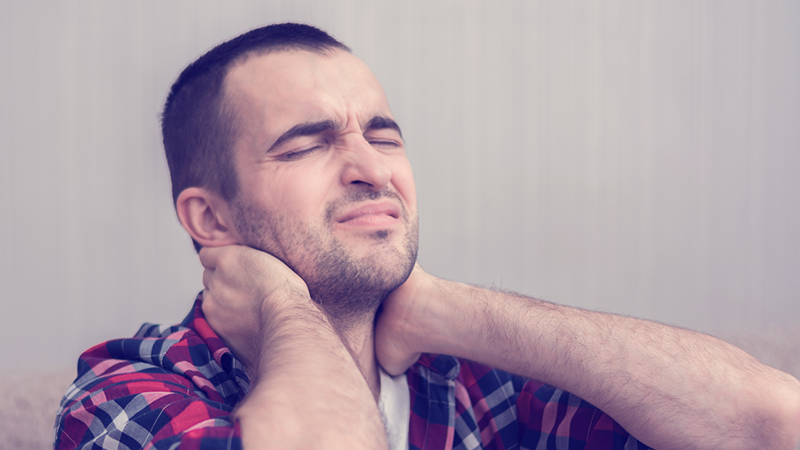Have you ever experienced discomfort that was hard to tell if it was a headache or neck pain? Last week I was on vacation in North Carolina and I spent time with my family. Although we had a great time, one evening I woke up with a terrible headache, except it wasn’t a headache. When visiting family, we tend to sit a lot during the day. On that day I had sat in a recliner for most of the day. I know, I do not like recliners, and I am about to explain why! In this house recliners were all they had to sit in and there were too many people to sit on the floor.
What is Causing the Headache or Neck Pain?
I have had this headache or neck pain before when riding in cars or airplanes with a headrest that leans forward. Recliners are built to feel ultra comfortable with fluffy padding and a thick headrest. Unfortunately, it pushes your head forward causing the muscles on the front of your neck to shorten. Then when you lay down to sleep, if you do not have a thick pillow, the muscles on the backside will spasm causing a massive headache on the back of your head.
To make matters worse, sitting in that position for long periods of time allows the chest muscles to shorten, as well as the front of the thighs. This causes the whole body to lean forward which can lead to low back pain to go along with the headache. Most people think of leaning forward as part of old age. Your recliner could be speeding up that process.
Most people love their recliners because it places them in a position that feels comfortable. Unfortunately that position may have long term affects they may not like. Some of you may opt to sleep in your recliner due to back pain or upper back pain. Sitting in a reclined position shortens the abdominal muscles, front of your thighs which can lead to low back pain. You may find the only way too sleep in your bed is to place a pillow under your knees to relieve the pain. This is a clear sign that the front of your thighs are too short. Others may find the upper back hurts or you get headaches when you lay in your bed and when you sit in the recliner it goes away. This is a sign that the chest muscles are too short and the muscles on the front of your neck are short as well.
How to Relieve the Pain?
When the pain occurs it feels like it will never stop. You may take pain killers, ice or heat on your neck, or just sit up for the night in your recliner. Car and airplane seats can be just as bad, depending on your height. I find the taller you are, the more some car and airplane seats can have the same affect. This is why so many people immediately recline their seats when they get into a car or airplane. Sitting in front of a computer for hours can have the same affect. Remember, when sitting in front of your computer or driving a car for long distances, stop every hour to 90 minutes, stand up, walk around, and stretch your neck and chest.
The Stretches
Begin by stretching the front of your neck. Place your chin in the palms of both hands. Feel the weight of your head just resting on your palms. Next, lift your head with your hands only. You should feel the weight of your head as you lift it, otherwise you may be using the muscles on the back side of your neck, which will not help you. Breathe out as you lift the head, feeling the muscles on the front side releasing. You can use ice on the back side of the neck if the pain is bad. This will help reduce some of the immediate pain and allow you to focus on stretching the frontside. I have added a couple of neck stretches below to get you started. Go back to my previous newsletters and see the chest stretches to make sure your chest is not adding to the problem.
Stretching is more about feeling the muscles letting go than forcing them to stretch. If you are forcing the muscle, you could be doing strength training, not stretching. Make sure you are feeling the intended muscle stretching. If not, the form could be wrong. Holding for 5 seconds allows the brain to release the muscle before it senses any danger. Repeating the stretches 10 times allows the brain to learn it is safe for the muscle to move that way.
Don’t forget the Tennis Ball Massage!
Softening your hips and back is easy when you use the tennis ball. Just lean against the wall and apply enough pressure to feel the painful area. The temptation is to press harder, but resist it. Instead, breathe out and allow the muscle to soften under the ball. Then move to another spot and repeat. Continue doing this until most of the painful spots are gone.
If you like this newsletter, please share with your friends and family. Don’t forget to check out our social media pages, leave a comment, and as always, reviews are awesome!
Learn About Stretching
Hopefully, you know more now about how to relive shoulder pain shooting down your arm if you have it. Learn more when you SUBSCRIBE to view all the videos that demonstrate Stretch n’ Release exercises to prevent running injuries and reduce pain.
Want to Talk with Me Directly? Start Here
We’re happy to offer you a complimentary 30-min virtual consultation so you can experience this for yourself. Schedule your introduction to Stretch n Release now.
About The Muscle Repair Shop
Drawing upon his personal experience as a former competitive athlete turned wheelchair, obese and chronic pain sufferer, Muscle Repair Shop Founder Butch Phelps decided to take his health into his own hands when at the age of 36 he was told he might not make it to his 40th birthday. Applying balanced nutrition advice from his doctor along with a sound exercise program, he went from 315 lbs. to 180 lbs. Motivated by his experience, he then acquired degrees in advanced therapeutic massage and aging sciences to help people eliminate chronic pain. This included applying his expertise in how people age, including the effects of dementia, anatomy, psychology, and the day-to-day struggles living as an older person to his practice and development of The Muscle Repair Shop’s one-of-a-kind Stretch n’ Release Technique.
Available through in-office and virtual coaching treatment sessions, this unique combination of stretching and breath work teaches the brain to release the emotional side of muscle tension and pain allows clients to find lasting relief and healing from stiffness, aches, injuries, and chronic pain. The at-home exercises come with customized instructional videos and virtual or in-office support, allowing clients to enjoy and experience life and sports as they did before limitations slowed or curtailed activities.


